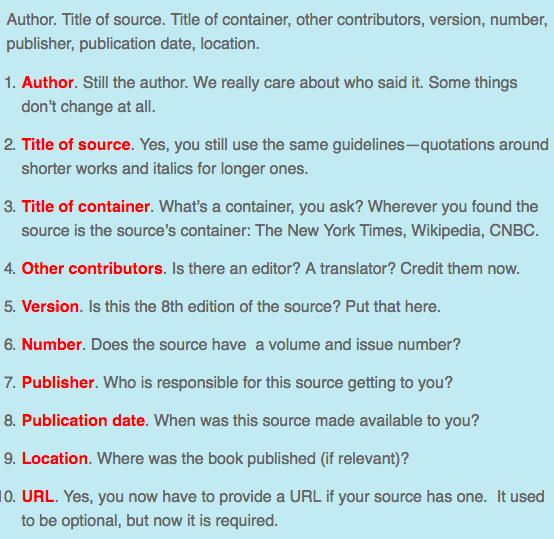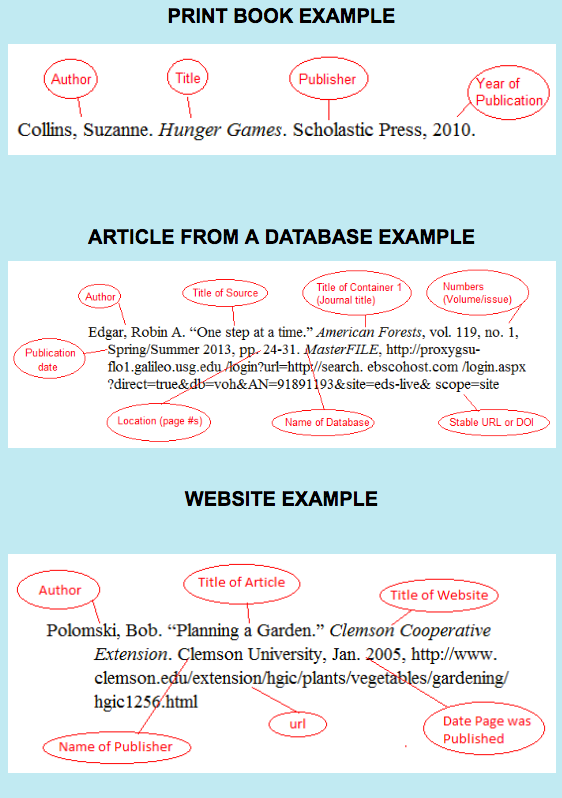Citing Sources
Why Cite?
- To avoid plagiarism (pla·gia·rize to use the words or ideas of another person as if they were your own words or ideas) definition courtesy of Merriam-Webster
- To show you have done your research The sources you used show the depth and scope of your research.
- To give credit to author whose ideas you used or words you quoted
- To allow readers to further explore the sources you used
Citation Help
Annotated Bibliographies |
Citation Creation Online Tools
Tips and Tricks |
MLA (Modern Language Association) 8
What is included in the citation?
Author. Title of source. Title of container, other contributors, version, number, publisher, publication date, location.
Author. Title of source. Title of container, other contributors, version, number, publisher, publication date, location.
MLA 8 Examples
In-text Citations (Parenthetical Citations)
In-text citations can let a reader know which facts were taken from each source.
Two basic options for MLA in-text (aka parenthetical) citations:
1. Author(s) and Location
"The eighth-century English historian, Bed tells of how, in AD 449, Hengist and Horsa were invited by the Celtic king Vortigern to help him against his enemies..." (Hogg 1).
2. Location only*
In his article, "The Distant Shore," Anderson states, "Only about a hundred groups of isolated indigenous people are believed to still exist, with more than half of them living in the wilderness that straddles Peru’s border with Brazil" (42).
*The author is not added to the in-text citation because he is already mentioned by name in the sentence. When such information is given, it is permissible to not repeat it inside the ( ).
A Variety of Locations:
Page numbers are the most common location used in a parenthetical citation; however, there are many others including:
Information taken from Georgia Highlands College
1. Author(s) and Location
"The eighth-century English historian, Bed tells of how, in AD 449, Hengist and Horsa were invited by the Celtic king Vortigern to help him against his enemies..." (Hogg 1).
2. Location only*
In his article, "The Distant Shore," Anderson states, "Only about a hundred groups of isolated indigenous people are believed to still exist, with more than half of them living in the wilderness that straddles Peru’s border with Brazil" (42).
*The author is not added to the in-text citation because he is already mentioned by name in the sentence. When such information is given, it is permissible to not repeat it inside the ( ).
A Variety of Locations:
Page numbers are the most common location used in a parenthetical citation; however, there are many others including:
- Poetry line numbers (line 44)
- Books, acts and other sections commonly found in literary works. For example: Shakespearean plays are cited by act, scene and line (4.3.56-9)
- Paragraphs (par. 56)
- Chapters (chap. 4)
- The "author" position in an in-text citation should match the first word(s) of the Works Cited list entry to allow readers easy access to full publication information whether that is another person (translator, editor, etc.) or the title of a work.
- Long titles should be abbreviated to avoid interrupting the flow of ideas. Example: "Learning Lessons From War? Inclusions and Exclusions in Teaching First World War History in English Secondary Schools." = ("Learning" 36)
- When using a title instead of a person's name, quotation marks or italics should be maintained, even for the abbreviated title.
- Summarized and paraphrased material must be documented with in-text citations!
- Citations should be at the end of a sentence to avoid interrupting the flow of ideas.
- Material synthesized from two sources should include both sources (Kirk 234; Spock 22-4).
- Page numbers, line numbers and other location information is not invented. If a source doesn't provide it, the writer cannot include it.
- New in the 8th edition, locations in videos and audio recordings are required and should be given as hours, minutes and seconds (1:23:45-7).
Information taken from Georgia Highlands College


